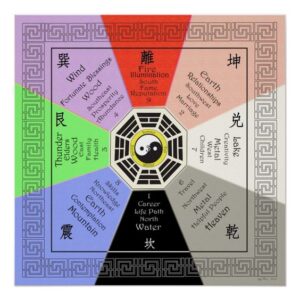![]() Understanding the Fundamentals of Feng Shui
Understanding the Fundamentals of Feng Shui
What is Feng Shu i?
i?
Feng Shui is an ancient Chinese philosophy, Feng Shui, (Feng represents wind and Shui represents water) focuses on the simplicity of life and the free flow of Chi – the force that permeates all aspects of life. As all living beings require both breath and water to live, we are forever linked to be one with Nature and by creating spaces that are designed with intention, this puts you in sync with your environment and promotes a new energy in your space that focuses on providing balance and tranquility to your life and home. To achieve the optimal results, the Feng Shui rules work within five elements and a pattern, called a Bagua map. These tools are essential and help guide the placement of furniture and décor throughout your home. Feng Shui principles are applied to various areas of life, including architecture, interior design, and even clothing choices.
The Core Principles of Feng Shui
The central principle of Feng Shui is to create balance and harmony between the five elements of nature, which include wood, fire, earth, metal, and water. The placement of objects and the use of colors within a space can have a significant impact on the flow of energy. The principles of Feng Shui also emphasize the importance of decluttering and organizing a space to promote peace and tranquility.
What is Bagua Map?
The second essential building block tool in all Feng Shui design is the Bagua Map. Bagua means “eight areas” in Chinese and each of the eight sections relates to a different aspect of your life, such as family, career, fame, wealth, knowledge, love, children, and travel. A ninth section is located in the center and represents you, as you will be guiding all of the decisions that are made.
Feng Shui Color Schemes for Different Rooms
Different colors have different meanings in Feng Shui and can impact a person’s energy levels and mood. For example, blue is associated with calm and relaxation, while red is believed to promote energy and excitement. Choosing the right colors for different rooms can create a balanced and harmonious environment.
Feng Shui Furniture Placement for Maximum Chi
The placement of furniture within a space can also impact Feng Shui. Furniture should be arranged in a way that promotes positive energy flow and allows for maximum “Chi” to circulate throughout a room. Furniture should also be placed in a way that aligns with the Feng Shui Bagua to promote balance and harmony.
The Significance of Colors in Feng Shui
Colors play a significant role in Feng Shui design, and the right color scheme can promote positive energy flow and balance within a space. Neutral and earthy tones are often used to create a calming environment, while brighter colors can promote energy and vitality.
Lighting can also impact Feng Shui, and the right lighting techniques can promote positive energy flow within a space. Natural light is believed to be the most auspicious, while soft and warm lighting can create a cozy and inviting atmosphere.
If you work in a shared workspace, feng shui principles can still apply. One tip is to create a personal “power spot” by placing a plant, photo, or other meaningful item on your desk. This can help you feel more grounded and focused, even in a busy and distracting environment.
Feng shui is not just limited to the workplace – it can also be applied to your home. When used effectively, feng shui can create a sense of balance and harmony in your living space. Here are some tips for using feng shui in interior design:
Feng Shui Tips for the Living Room
The living room is often the heart of the home, and feng shui can help create a warm and inviting atmosphere. One tip is to position your furniture in a way that encourages conversation and social interaction. Avoid placing furniture in a way that blocks the flow of energy or creates a sense of clutter.
Feng Shui Tips for the Bedroom
The bedroom is an especially important area for feng shui, as it is where we go to rest and recharge. To create a sense of calm and tranquility, try to eliminate any electronics or distractions. Position your bed in a way that allows you to easily see the door, and choose soothing colors and soft lighting to promote relaxation.
Feng Shui Garden Design: Creating a Serene Outdoor Space
To create a feng shui garden, consider incorporating water features, such as fountains or ponds, to promote relaxation and tranquility. You can also add plants with different textures and heights to create a sense of diversity and balance.
Water features such as fountains or ponds are one of the most effective ways to incorporate feng shui into your outdoor space. In addition to promoting relaxation and tranquility, water features can also attract positive energy and promote abundance and prosperity. Incorporating Feng Shui principles into your design can elevate your living space to a whole new level of harmony and tranquility. Whether you are looking to boost productivity in the workplace, create a serene outdoor space, or simply create a more balanced home, the application of Feng Shui can help you achieve your goals. By implementing the concepts and techniques outlined in this article, you can create a living space that is not just aesthetically pleasing, but also promotes positive energy and well-being.
What is the main goal of Feng Shui in design?
Feng Shui is about creating a harmonious living space that supports our physical and emotional needs. The goal of Feng Shui is to create a balanced environment that promotes positive energy and well-being.
How can I apply Feng Shui principles to my home or office?
There are many ways to incorporate Feng Shui principles into your living or working space. Some examples include using specific colors and lighting techniques, arranging furniture and decorative objects in a specific way, and incorporating natural elements into your design.
Do I need to have a deep understanding of Feng Shui to apply its principles in design?
No, you don’t need to have a deep understanding of Feng Shui to apply its principles in design. However, it can be helpful to have a basic understanding of the core principles and techniques so that you can create a harmonious living space that supports your needs and promotes positive energy.

